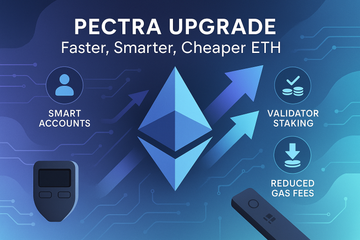Change is one thing Ethereum fans have gotten used to, but every now and then, something bigger lands on the scene and makes everyone in crypto sit up straighter. The upcoming Pectra upgrade is exactly that—a combination of ambition, innovation, and developer hustle. If you have ETH in cold storage, fiddle with stakers like Trezor or Ledger, or just love watching your gas fees, you’re about to see more change than you bargained for.
So, What’s This Pectra Thing Anyway?
Let’s keep it simple: the Pectra upgrade wraps together two upgrades—the Prague changes to Ethereum’s execution layer and the Electra update on the consensus layer. Instead of releasing these tweaks piecemeal, developers decided, 'Why not launch them together and save everyone a few headaches?' It’s like doing all your spring cleaning and home renovations in one wild weekend. Except, in this case, the goal is smoother transactions, leaner operations for validators, and a future-proofed experience for users and institutions alike.
Why Now? Because Ethereum Doesn’t Stand Still
The last few years have proven that crypto is like a river after a storm—if you stand still for even a minute, you’re going to be washed downstream. Ethereum has had its fair share of upgrades: The Merge was historic. But user demands keep evolving, institutional money is coming in, and dApps are hungrier for speed and reliability. Honestly, who can blame them?
That’s why the Pectra upgrade isn’t just about technical finesse—it’s about responding to what wallet users, validators, and developers need right now (and probably what they’ll need next year, too).
What’s in the Box? Features You’ll Notice (or Maybe Just Feel)
Here’s where things get interesting. Let’s break down what you can expect from Pectra that actually matters in the real world:
- Smart Accounts (EIP-7702): This one’s a game changer for wallets. Imagine your crypto wallet working a bit like an app—capable of batching transactions, setting rules, or paying gas in different currencies, all without feeling like you’re trying to program a vending machine in an airport. Suddenly, self-custody feels less intimidating and a whole lot smarter.
- Bigger Stakes for Validators (EIP-7251): The old 32 ETH per validator cap? Pectra’s blowing that wide open, letting validators stake up to 2,048 ETH. That means fewer validator accounts for power users and institutions, and much less tech juggling. If your Ledger or Trezor is heavy with ETH, this really matters.
- Layer 2 Bliss: Developers and users both win with bigger “blob” storage, which basically means cheaper, faster Layer 2 transactions. You might not see the magic, but your gas fees could start dropping. I mean, who doesn’t want that?
Transitioning to a Smarter Account System
You know how crypto wallets often feel like they’re stuck in 2013? Pectra introduces smart accounts, letting users interact with Ethereum as if their wallet itself was a mini-program. Not only does this tighten up security, but it opens the door for smoother password resets, bundled transactions, and even universal logins for dApps. Ledger’s latest academy guide points out this could finally make onboarding as frictionless as setting up an app on your phone.
Trezor, Ledger, and 'Stake Nation'—What’s the Angle?
For hardware wallet companies, supporting complex upgrades isn’t just a nice-to-have—it’s table stakes. Ledger and Trezor are already prepping their ecosystems for the technical side of Pectra so their users can stake more easily, claim rewards, and tap into those smart account features with less fuss. For anyone managing their own validators, a seamless experience means less downtime and fewer 'what did I break this time?' moments.
Validator Operations: More Power, Less Hassle
If you’ve ever been in a Telegram channel for node operators, you know that 'keep it simple' is sacred. Pectra’s validator changes mean fewer keys, fewer missed rewards, and—for the bigger fish—less operational overhead. It’s as if Ethereum’s telling big validators, 'Let’s make this worth your while, but keep everyday stakers in the loop, too.' Maybe it’s not revolutionary, but it sure is convenient.
Security Is Still the Name of the Game
This all sounds great, but if you’re like most people in crypto, you’ve learned to approach upgrades with raised eyebrows (and a backup of everything). Pectra doesn’t ignore security: with smart contract wallets and higher validator caps, they’re tightening protocol controls and adding new tests to spot problems before they go live. No one wants another rogue validator making headlines or a wallet exploit trending on Crypto Twitter.
Real World Impact: Not Just for the Hardcore Crowd
Here’s the thing—Pectra isn’t just for megawatt miners and DeFi degens. Everyone touches Ethereum now, whether through swaps, marketplaces, NFTs, or those random airdrops you forgot you qualified for. The upgrade promises:
- Smoother onboarding for users (even grandma with a hardware wallet gets a break)
- Lower and more predictable gas fees, especially as blobs grow larger
- Stronger, more flexible security controls for both wallet builders and everyday holders
- More tools for devs to create the next viral dApp or NFT marketplace
Does this mean Ethereum will suddenly dethrone legacy finance and save the world? Maybe that’s a stretch. But it’ll make every ETH transaction a little more like what we want: fast, cheap, and trustworthy.
Wrapping Up: Is Pectra the Upgrade You Didn’t Know You Needed?
Ethereum’s Pectra upgrade shows how the network is maturing and meeting the moment. Whether you’re using a Trezor or Ledger every day, tinkering with validator pools, or just hodling and watching, you’ll feel the effects—some subtle, some not so much. Hardware wallet providers are ready, developers are eager, and even the skeptics are paying attention.
So next time you do a swap, move some ETH, or just check on your staked balance, remember: behind the scenes, Pectra’s helping the pipes run cleaner, faster, and just a bit smarter. Progress may be slow and sometimes messy, but if you’ve bet on Ethereum for the long haul, this upgrade is more than just a line in a changelog—it’s a quiet leap forward.











